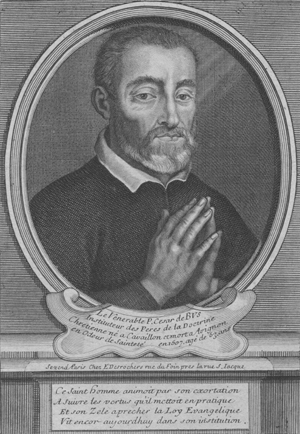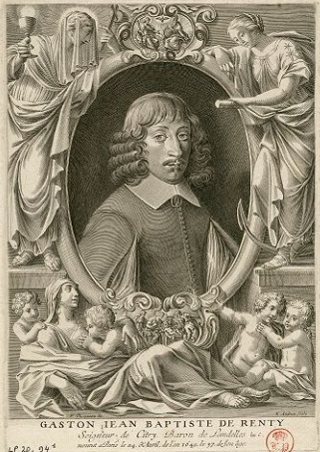Related Research Articles
Primate is a title or rank bestowed on some important archbishops in certain Christian churches. Depending on the particular tradition, it can denote either jurisdictional authority or (usually) ceremonial precedence.
Hippolyte Hélyot (1660–1716) was a Franciscan friar and priest of the Franciscan Third Order Regular and a major scholar of Church history, focusing on the history of the religious Orders.

Grandmontines were the monks of the Order of Grandmont, a religious order founded by Saint Stephen of Thiers, towards the end of the 11th century. The order was named after its motherhouse, Grandmont Abbey in the eponymous village, now part of the commune of Saint-Sylvestre, in the department of Haute-Vienne, in Limousin, France. They were also known as the Boni Homines or Bonshommes.
The Congregation of St. Maur, often known as the Maurists, were a congregation of French Benedictines, established in 1621, and known for their high level of scholarship. The congregation and its members were named after Saint Maurus, a disciple of Saint Benedict credited with introducing the Benedictine rule and life into Gaul. The congregation was suppressed and its superior-general executed during the French Revolution.

Whithorn Priory was a medieval Scottish monastery that also served as a cathedral, located at 6 Bruce Street in Whithorn, Wigtownshire, Dumfries and Galloway.

The Valliscaulian Order was a religious order of the Catholic Church. It was named after Vallis Caulium or Val-des-Choux, its first monastery, located in Burgundy. The order was founded at the end of the twelfth century and lasted until its absorption by the Cistercians in the eighteenth century.
Laurent Bénard (1573–1620) was a chief founder of the Congregation of Saint-Maur.

Cistercian nuns are female members of the Cistercian Order, a religious order belonging to the Roman Catholic branch of the Catholic Church.
The Brothers of Penitence or Friars of the Sack were an Augustinian community also known as Boni Homines or Bonshommes, with houses in Spain, France and England.

Ashridge Priory was a medieval college of Austin canons called variously the "Brothers of Penitence" or the "Boni Homines". It was founded by Edmund of Almain in 1283 who donated, among other things, a phial of Christ's blood to the abbey. It was granted to Mary Tudor, Queen of France and later became the private residence of the future queen Elizabeth I. It was acquired by Sir Thomas Egerton in 1604 and then passed down to the Duke of Bridgewater before being demolished.
The Portuguese Boni Homines, or Secular Canons of St. John the Evangelist, were a Catholic religious institute. They were founded by John Vicente, afterwards Bishop of Lamego, in the fifteenth century. Living at first independently in a monastery granted to them by the Archbishop of Braga at Villar de Frades, they afterwards embraced the institute of Secular Canons of St. George in Alga, and the Portuguese order was confirmed by Pope Martin V under the title of "Boni Homines". They had fourteen houses in Portugal, and King João III gave them charge of all the royal hospitals in the kingdom, while many of the canons went out as missionaries to India and Ethiopia. Several members of the order won a high reputation as scholars and theologians.
Mathieu-Richard-Auguste Henrion was a Baron, French magistrate, historian, and journalist. After completing his studies in law, he became a member of the Paris Bar as avocat à la cour royale. Under the July Monarchy he was made assistant librarian at the Bibliothèque Mazarine; Napoleon III appointed him counsellor at the court of appeals of La Guadeloupe, whence he was transferred in the same capacity to the court of Aix, a position which he occupied until his death.

César de Bus was a French Catholic priest and founder of two religious congregations.
Congregation of the Presentation may refer to several Roman Catholic female religious congregations
The Congregation of Our Lady of Calvary is a Roman Catholic Benedictine religious congregation, founded at Poitiers in 1617.

Gaston Jean Baptiste de Renty was a French aristocrat and philanthropist. He ruled the Compagnie du Saint-Sacrement between 1639 and 1649, and was under the influence of the French Oratorians, through his confessor Paul de Condren.
The Haudriettes were a religious congregation founded in Paris early in the fourteenth century by Jeanne, wife of Étienne Haudry, a private secretary of Louis IX, king of France.

The Order of the Porcupine was established by Louis de France, Duke of Orléans, in 1394, at the occasion of his elder son Charles of Orléans' baptism.
The Order of Christian Charity was, supposedly, founded in 1589 by the French King Henry III and was granted to disabled veterans.
The Brazilian Congregation is a monastic congregation of the order of Saint Benedict. Founded in 1827, it is a member of the Benedictine Confederation.
References
- ↑ L'Histoire des ordres monastiques, religieux et militaires, et des congregations séculières de l'un et de l'autre sexe, qui ont été établis jusqu'à présent, Pierre Helyot (1714–21), cited in Blair, David Oswald Hunter (1907). . In Herbermann, Charles (ed.). Catholic Encyclopedia . Vol. 2. New York: Robert Appleton Company.
- ↑ Blair, David Oswald Hunter (1907). . In Herbermann, Charles (ed.). Catholic Encyclopedia . Vol. 2. New York: Robert Appleton Company.